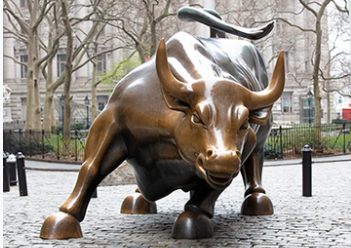
(Photo : wikimedia.org)
- Wall Street surged on Tuesday, led by a rebound in tech stocks, despite concerns over Trump's tariff promises and Federal Reserve's minutes.
- The Federal Reserve's minutes revealed a division over potential need for further interest rate cuts, impacting U.S. short-term interest-rate futures.
- Trump's proposed tariffs on Canadian, Mexican, and Chinese imports impacted automakers Ford and General Motors, causing their stocks to drop.
- Despite these concerns, the Dow Jones, S&P 500, and Nasdaq Composite all saw gains, largely driven by megacaps like Microsoft and Apple.
Wall Street experienced a surge on Tuesday, with the S&P 500 and the Nasdaq leading the charge. This upward trend was largely driven by a rebound in technology stocks, even as investors grappled with President-elect Donald Trump's tariff promises on major trade partners and the latest minutes from the Federal Reserve.
The Federal Reserve's minutes from the November 6-7 meeting revealed a division among officials over the potential need for further interest rate cuts. This news led to a reduction in earlier losses in U.S. short-term interest-rate futures. The minutes also indicated a consensus among the group to avoid providing specific guidance on the likely trajectory of U.S. monetary policy in the coming weeks.
Jamie Cox, managing partner for Harris Financial Group, stated, The minutes did nothing to alter my view that the policy rate is going to be adjusted lower next week and will continue to do so through the next calendar year.
Impact of Tariff Announcements and Market Reactions
However, other analysts, like Paul Ashworth, chief North America economist for Capital Economics, were more cautious. Ashworth noted that while he anticipates another 25 basis-point cut, such decisions are data-dependent, and November's employment and inflation data will be pivotal.
In an overnight development, Trump announced his intention to impose a 25% conditional tariff on Canadian and Mexican imports that could violate a free-trade deal he negotiated during his previous term. He also proposed an additional 10% tariff, above any additional tariffs on imports from China, escalating the risk of trade wars.
This news had a significant impact on automakers Ford and General Motors, both of which saw their stocks drop due to their highly integrated supply chains across Mexico, the U.S., and Canada. GM shares, in particular, plunged nearly 9%. Robert Pavlik, senior portfolio manager at Dakota Wealth, expressed concerns that some products could become more expensive, leading to a decline in revenue for companies manufacturing those goods overseas.
Market Performance and Historical Echoes
Despite these concerns, the Dow Jones Industrial Average rose 123.74 points, or 0.28%, to 44,860.31, the S&P 500 gained 34.26 points, or 0.57%, to 6,021.63, and the Nasdaq Composite gained 119.46 points, or 0.63%, to 19,174.30. These gains were largely driven by megacaps such as Microsoft and Apple, which boosted the information technology sector and the tech-heavy Nasdaq. Microsoft shares, for instance, rose a little over 2%.
Wells Fargo stood out among sluggish banking stocks, rising 0.6% after Reuters reported that the bank is in the final stages of a process to pass regulatory tests to lift a $1.95 trillion asset cap next year after addressing issues from its scandal over fake accounts. However, the blue-chip Dow was weighed down by declines in Amgen, which slid about 4.8% after its experimental obesity drug fell short of expectations.
The S&P 500 touched a record high on Monday and logged its sixth-straight session of gains, while the Russell 2000 also scaled an all-time high after three years. On the day, the small-cap index fell 0.7%. Among others, Eli Lilly rose 4.6% after U.S. President Joe Biden proposed expanding Medicare and Medicaid coverage for anti-obesity drugs.
Declining issues outnumbered advancers by a 1.57-to-1 ratio on the NYSE. There were 358 new highs and 52 new lows on the NYSE. The S&P 500 posted 63 new 52-week highs and 3 new lows while the Nasdaq Composite recorded 124 new highs and 91 new lows.
This recent market activity echoes historical events where political decisions and economic indicators have significantly influenced stock market trends. For instance, during the 2008 financial crisis, the Federal Reserve's decisions on interest rates and government policies played a crucial role in market movements. Similarly, President Trump's tariff announcements recall the trade wars of the 1980s, which led to significant market volatility.









